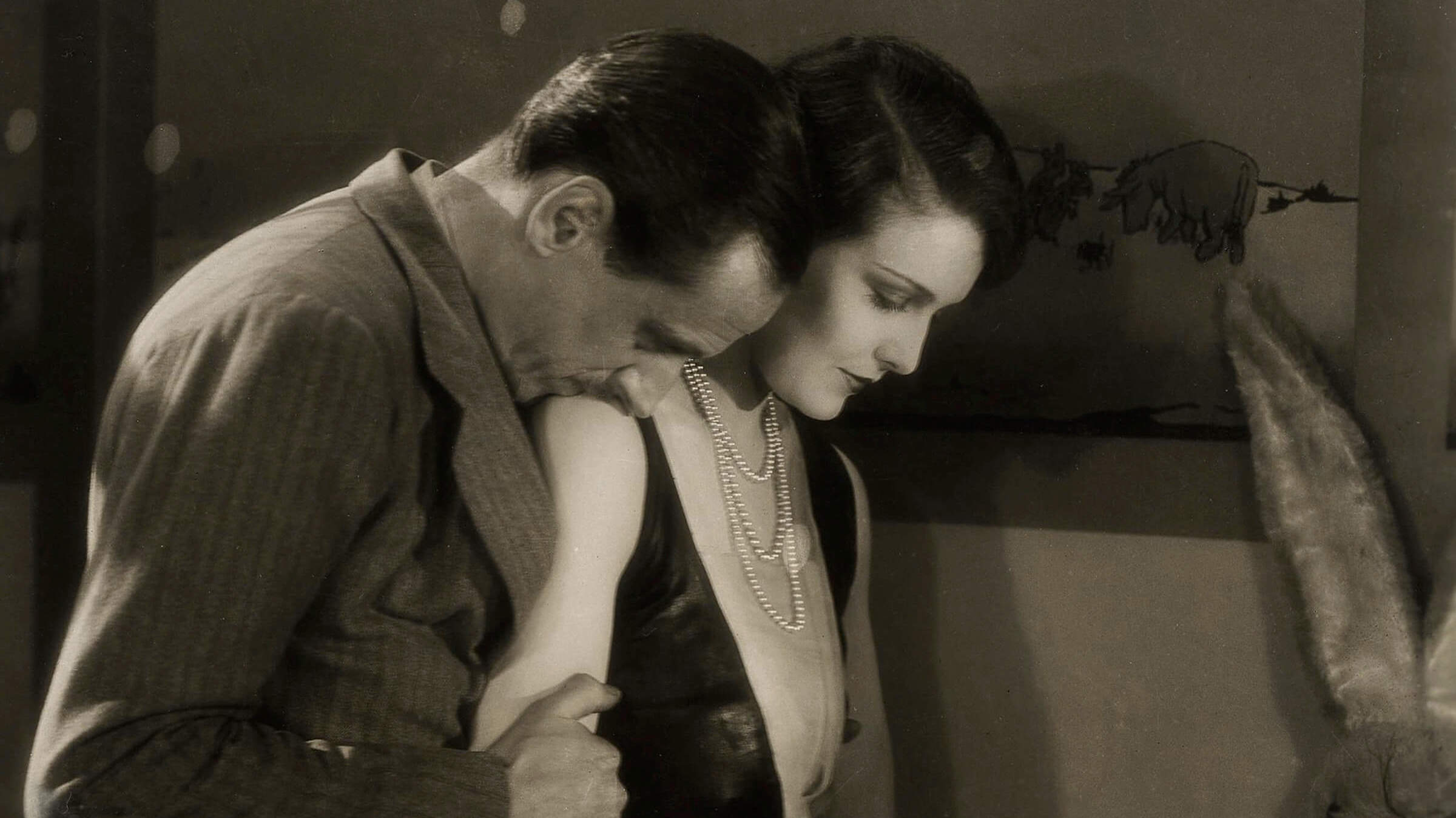A sexually provocative melodrama of upper-class decadence with surprisingly sophisticated stylistic flourishes, The First Born is the collaboration of two key players in the British film industry of the 1920s and ’30s whose work has largely fallen into obscurity, Miles Mander and Alma Reville.
Best known as a character actor in Hollywood films of the 1930s and ’40s, Mander appeared in more than 100 films between 1920 and his death in 1946. Yet that is only part of his story. He lived a colorful and varied life, according to a recent Guardian article, with “a background in boxing promotion, aviation, and sheep farming.” In the 1920s, he was a dynamo, writing and publishing novels and plays, as well as directing, producing, writing, and acting in films. In 1912, Mander married Princess “Pretty” Pretiva, sister of the maharaja of Cooch Behar. Ten years later in 1922, they had a scandalous divorce. A one-time race car driver, Mander was charged twice with “driving at high speeds dangerous to the public,” while directing 1936’s The Flying Doctor in Australia. In Hollywood, Mander often played the same kind of upper-class cads that he portrayed in First Born. (He died of a heart attack at the Brown Derby restaurant at the age of 57.)
Alma Reville is best known as Mrs. Alfred Hitchcock. She began working in film at the age of 16, in 1915 —a five-year head start on her future husband. Her first job was editor, or what was called “rewind girl,” at the London Film Company. Its leading director, Maurice Elvey, promoted her to second assistant director, her main duties to oversee editing and continuity of his films. As Nathalie Morris wrote in her 2006 article The Early Career of Alma Reville, “At this time, cutting and continuity represented an obvious combination of duties and was instrumental in enabling a number of female editors to get onto the studio floor and thereby advance their careers.”
In 1921, Reville moved to the British branch of Famous Players-Lasky, which had studios in Islington, continuing in her dual role as editor and continuity as well as serving as second assistant director on films such as the Donald Crisp-directed melodrama Appearances (1921), for which Alfred Hitchcock designed the intertitles. The next year, Famous Players-Lasky closed its London studio and Michael Balcon re-opened it as Gainsborough Pictures. The now legendary producer gave Hitchcock the opportunity as assistant director on Woman to Woman (1923). Hitchcock immediately contacted Reville, who was now between jobs, to offer her the editor-continuity position on the film.
By then, Reville had already made a name for herself within the industry. She wrote “Cutting and Continuity” for the January 1923 edition of The Motion Picture News, an American industry trade paper. In it, she advised professionals how best to prepare for the editing phase of a film: “If Mr. Producer would give just a little more forethought to the continuity and cutting of his production before commencing it—and keep these two words continually in his mind whilst he is building it up—how much worry and time he could save in the cutting-room.” Pictures and the Picturegoer, a British movie magazine, published a profile of her in December 1925 titled “Alma in Wonderland: An interesting article, proving that a woman’s place is not always in the home.”
British film historian Charles Barr identifies Reville as a key player at Gainsborough Pictures. After Woman to Woman, Reville and Hitchcock collaborated on The White Shadow (1924), The Passionate Adventure (1925), and The Prude’s Fall (1926), with Reville on continuity and editing and Hitchcock as assistant director, although she is only credited on The White Shadow. They also worked together at Berlin’s Ufa studios on the British-German coproduction The Blackguard (1925). As they sailed home to England, with Reville horribly sea sick, Hitchcock asked her to marry him.
The duo teamed up on their next three films, with Reville as assistant director and Hitchcock in the director’s chair. Gainsborough offered Hitchcock the chance to direct 1925’s The Pleasure Garden, followed by The Lodger (1926) and The Mountain Eagle (1927). After the release of The Lodger, the two were married. Reville continued to work officially on Hitchcock and non-Hitchcock films throughout the 1930s, including on Sally in Our Alley (1931), Nine Till Six (1932), and The Passing of the Third Floor Back (1935), starring Conrad Veidt. Later in her career, she is credited as screenwriter on the Richard Wallace-directed film It’s in the Bag! (1945) and a handful of Hitchcock’s such as Suspicion (1941), Shadow of a Doubt (1943), The Paradine Case (1947), and Stage Fright (1949). Starting in the late 1940s, Reville began to work almost solely on her husband’s films, becoming Hitchcock’s most significant, yet uncredited, collaborator. Her work was absorbed into Alfred Hitchcock’s persona and motion picture output.
The First Born is one of Reville’s most striking non-Hitchcock films. She and director Miles Mander adapted the film from the novel Oasis and the play Those Common People, both written by Mander. The New York Times said about the film, which was released at the end of the silent era, “The most interesting film, whether sound or silent, I have seen this week is ‘The First Born,’ a tragic and rather morbid presentment of the troubles that await a woman who falls in love with a dissolute man.”
Some Hitchcock-like elements can be detected in The First Born. Objects, for example, are used to convey meaning, as when an overhead shot of a dinner table dissolves into a record spinning on a Victrola or when an upper-class woman carelessly knocks over a delivery bicycle as she drives away. Instead of reflecting a single influence, however, it is more likely that British filmmakers, working together as a community at studios in London or meeting through mutual colleagues, socialized and exchanged ideas. Mander formed the Atlas Bioscope company with actor Ivor Novello in 1922. Novello later appeared as the mysterious tenant in The Lodger and acted in a number of other Hitchcock and Reville films in the 1920s and ’30s. Mander worked with the Reville-Hitchcock team a number of times before directing The First Born. He appeared in The Pleasure Garden, The Prude’s Fall (1926), and, later, in Murder! (1930) and Mary (1931).
Hitchcock and Reville worked with screenwriter Eliot Stannard, who wrote eight of Hitchcock’s first nine films. Stannard provided very detailed scripts containing numerous and detailed descriptions of camera shots, movement, transitions, and even effects. As film historian Ian W. Macdonald concluded in 2007, “British screenwriters had a more substantial and detailed creative role in the conceptualization of the film than they are conventionally credited with.” Hitchcock and Reville’s experience working with Stannard surely helped to develop their voice as filmmakers.
In turn, it is likely Reville’s contribution to Mander’s The First Born extended beyond the duties of a scriptwriter, considering her then 12 years in the film industry. Bryony Dixon, curator at the British Film Institute, writes, “…there are layers of complexity in Mander’s original story, subtly told and honed by the experienced Reville, who almost certainly supplied the film’s ‘Hitchcockian touches.’” Coming at the end of the silent era, The First Born stands out as a high point in British silent cinema and in the careers of both Miles Mander and Alma Reville.
Presented at SFSFF 2013 with live music by Stephen Horne

